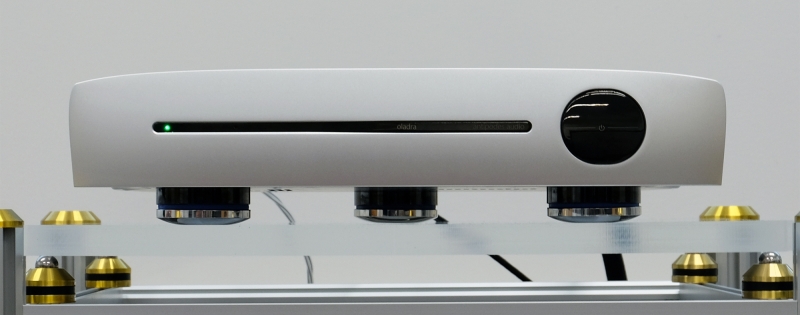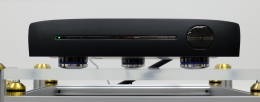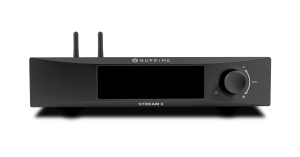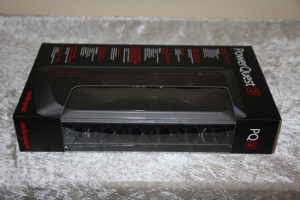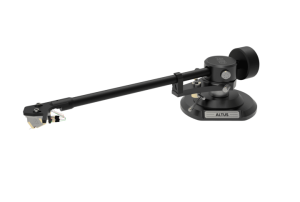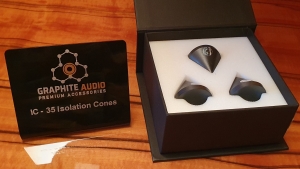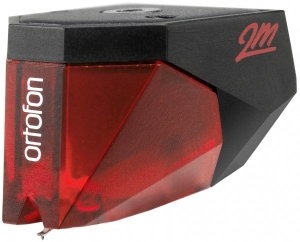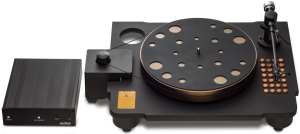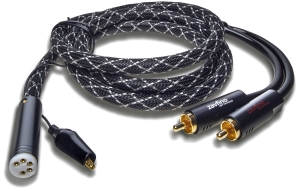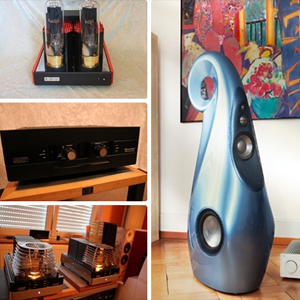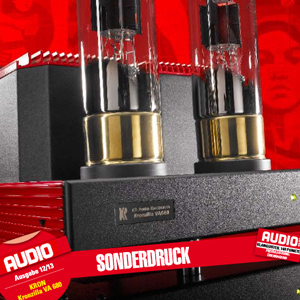| Warenwert: | 0,00 € | ||
Art.Nr.: antipodes-oladra
Hersteller: Antipodes
Antipodes Oladra
The Oladra integrates Server, Player and Reclocker functions in a single and beautifully elegant chassis (learn more about Server/Player/Reclocker functions). The Oladra uses our latest power supply and computing platforms to deliver the best sound quality in our music server range.
The power supply is a radical new innovation that removes all linear elements and uses three layers of switched mode regulation stages employing state-of-the-art active filters. Over the last decade switched mode technology has developed at a much faster pace than linear power supply technology, and many high-end firms are discovering that it is now possible to make better sounding products by eliminating linear power supplies. Today, this approach not only avoids the magnetic and electronic interference that comes with using power transformers, but now also achieves lower noise and higher transient response than any linear power supply can achieve, and results in a much cleaner and accurate square wave output to your DAC. The cascaded regulation approach used in the Oladra is complex and expensive to implement, but is used to optimise the power supply characteristics for each active element. In terms of sound quality, the result is a much greater sense of ease, musical flow, and naturalness of the music.
Server
The Oladra employs our new high-power V7H computing engine to run Server apps (such as, Squeeze Server, Roon Server, HQPlayer Server, Plex Server, etc). This is an entirely different board than the one used in the K50, dramatically improving Server app performance. Users can easily install their own SSD storage – 3 disks, up to 24TB. The Server computing engine has 64GB of RAM installed, offers an external Direct Stream link to play to the Ethernet input on a DAC, and has an ultra-high-speed proprietary link to stream to the Player engine.
Player
The Oladra employs our new mid-power V7X computing engine to run Player apps (such as Squeeze (Squeezelite), Roon (Roon Ready), HQPlayer NAA, MPD, etc). This board is based on the Player board in the K50 but all chipsets are upgraded, together with a range of other circuit improvements. The Player computing engine has 8GB of RAM installed, offers a USB Audio output to play to the USB input on a DAC, and provides galvanically isolated transmission to the Reclocker engine.
Reclocker
The Oladra employs a powerful, FPGA managed, oven-controlled, high-end clock, fed by a high-quality local power supply employing Graphene super-capacitor smoothing, and discrete line drivers for S/PDIF (RCA & BNC), I2S (RJ45 & HDMI), AES3 (3-pin XLR) outputs. This board includes higher-specified circuitry compared to the K50. Completing the first synchronous clocking step outside the DAC allows us to use far more processing power than should be used inside a DAC. Your DAC will perform another reclocking step but the result is greatly enhanced by the Oladra feeding it with a precision-timed signal. For this reason, and because noisy USB and Ethernet stages are not required to be used inside your DAC, the Oladra’s synchronous outputs (S/PDIF, AES3, I2S) will provide you with the best sound quality.
Because the Oladra uses the world’s best available clock designed for audio, we make this clock available as a reference for any other device you have that can be slaved to a master clock. The master clock output is on BNC. Some DACs also offer master clock outputs for the same reasons. Master clock outputs are only useful for components that can be slaved to them. Some DACs have clock slave inputs and these can be connected to the Oladra. But you should not connect the Oladra Master clock output to a master clock output on another device.
Design
A premium high-end product demands a premium chassis that is distinctive, and that will stand the test of time.
The Oladra case design is in two parts: a bottom/back thick plate assembly holding all of the electronics; and a one-piece front/top/sides carved from a single solid block of special grade alloy to provide elegant lines with no visible screws. The result is a very rigid and inert case that is also an object of timeless beauty.
The electronic design took the Project Oladra approach to its ultimate, to deliver an even better sounding music server than the much-acclaimed K50. Most of the electronics are totally new, and the remainder is based on the K50 with significant design and parts upgrades. The Oladra is consistent with, and improves on the qualities of all other Antipodes music servers, delivering an organically real sound, that also excels in detail, imaging, decays, timbre and dynamics.
What you will experience, compared to the K50, is a larger, deeper, more open and enveloping soundstage, that brings you closer, and conveys much more of the scale and drama of the musical event. This is simply because the Oladra is more true to the music. The better your system, the more pronounced the increase in scale and drama will be, and that is what the Oladra is all about – a digital source for the very best sound systems. The K50 continues to be an absolute winner at its price-point, but the Oladra takes things to a distinctly new level.
Specifications
Hersteller: Antipodes
Antipodes Oladra
The Oladra integrates Server, Player and Reclocker functions in a single and beautifully elegant chassis (learn more about Server/Player/Reclocker functions). The Oladra uses our latest power supply and computing platforms to deliver the best sound quality in our music server range.
The power supply is a radical new innovation that removes all linear elements and uses three layers of switched mode regulation stages employing state-of-the-art active filters. Over the last decade switched mode technology has developed at a much faster pace than linear power supply technology, and many high-end firms are discovering that it is now possible to make better sounding products by eliminating linear power supplies. Today, this approach not only avoids the magnetic and electronic interference that comes with using power transformers, but now also achieves lower noise and higher transient response than any linear power supply can achieve, and results in a much cleaner and accurate square wave output to your DAC. The cascaded regulation approach used in the Oladra is complex and expensive to implement, but is used to optimise the power supply characteristics for each active element. In terms of sound quality, the result is a much greater sense of ease, musical flow, and naturalness of the music.
Server
The Oladra employs our new high-power V7H computing engine to run Server apps (such as, Squeeze Server, Roon Server, HQPlayer Server, Plex Server, etc). This is an entirely different board than the one used in the K50, dramatically improving Server app performance. Users can easily install their own SSD storage – 3 disks, up to 24TB. The Server computing engine has 64GB of RAM installed, offers an external Direct Stream link to play to the Ethernet input on a DAC, and has an ultra-high-speed proprietary link to stream to the Player engine.
Player
The Oladra employs our new mid-power V7X computing engine to run Player apps (such as Squeeze (Squeezelite), Roon (Roon Ready), HQPlayer NAA, MPD, etc). This board is based on the Player board in the K50 but all chipsets are upgraded, together with a range of other circuit improvements. The Player computing engine has 8GB of RAM installed, offers a USB Audio output to play to the USB input on a DAC, and provides galvanically isolated transmission to the Reclocker engine.
Reclocker
The Oladra employs a powerful, FPGA managed, oven-controlled, high-end clock, fed by a high-quality local power supply employing Graphene super-capacitor smoothing, and discrete line drivers for S/PDIF (RCA & BNC), I2S (RJ45 & HDMI), AES3 (3-pin XLR) outputs. This board includes higher-specified circuitry compared to the K50. Completing the first synchronous clocking step outside the DAC allows us to use far more processing power than should be used inside a DAC. Your DAC will perform another reclocking step but the result is greatly enhanced by the Oladra feeding it with a precision-timed signal. For this reason, and because noisy USB and Ethernet stages are not required to be used inside your DAC, the Oladra’s synchronous outputs (S/PDIF, AES3, I2S) will provide you with the best sound quality.
Because the Oladra uses the world’s best available clock designed for audio, we make this clock available as a reference for any other device you have that can be slaved to a master clock. The master clock output is on BNC. Some DACs also offer master clock outputs for the same reasons. Master clock outputs are only useful for components that can be slaved to them. Some DACs have clock slave inputs and these can be connected to the Oladra. But you should not connect the Oladra Master clock output to a master clock output on another device.
Design
A premium high-end product demands a premium chassis that is distinctive, and that will stand the test of time.
The Oladra case design is in two parts: a bottom/back thick plate assembly holding all of the electronics; and a one-piece front/top/sides carved from a single solid block of special grade alloy to provide elegant lines with no visible screws. The result is a very rigid and inert case that is also an object of timeless beauty.
The electronic design took the Project Oladra approach to its ultimate, to deliver an even better sounding music server than the much-acclaimed K50. Most of the electronics are totally new, and the remainder is based on the K50 with significant design and parts upgrades. The Oladra is consistent with, and improves on the qualities of all other Antipodes music servers, delivering an organically real sound, that also excels in detail, imaging, decays, timbre and dynamics.
What you will experience, compared to the K50, is a larger, deeper, more open and enveloping soundstage, that brings you closer, and conveys much more of the scale and drama of the musical event. This is simply because the Oladra is more true to the music. The better your system, the more pronounced the increase in scale and drama will be, and that is what the Oladra is all about – a digital source for the very best sound systems. The K50 continues to be an absolute winner at its price-point, but the Oladra takes things to a distinctly new level.
Specifications
- Direct Stream Ethernet Output: Yes
- USB Audio 2.0 Output
- PCM to 32 bit/768kHz
- DoP to DSD256
- Native DSD to DSD512
- S/PDIF Output on RCA & BNC
- PCM to 24bit/192kHz
- DoP to DSD64
- AES3 Output on XLR
- PCM to 24bit/192kHz
- DoP to DSD64
- I2S Output on HDMI & RJ45
- PCM to 32bit/384kHz
- DoP to DSD256
- Native DSD to DSD512
- User installable storage: 3Bay SSD Slide-In / Up to 24TB
- Hardware Modules: V7H / V7X / R2i
- AC Supply: Switchable by Authorised Technician
- 110-120VAC 60Hz
- 220-240VAC 50Hz
- Width: 445mm
- Depth: 370mm
- Height: 80mm
- Weight: 21kg
Beratung & Service
Mo.-Fr.: 09-16:30 Uhr
+49 [0] 33 22 - 2 13 16 55

